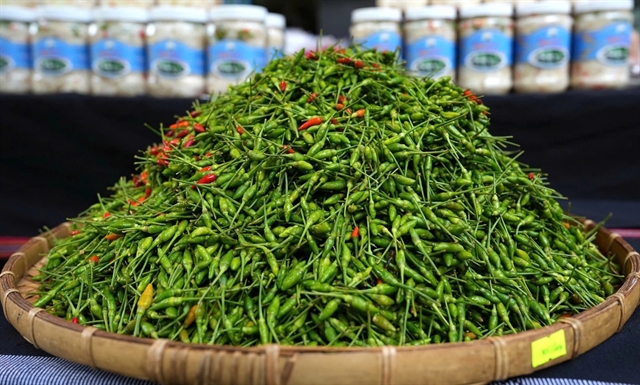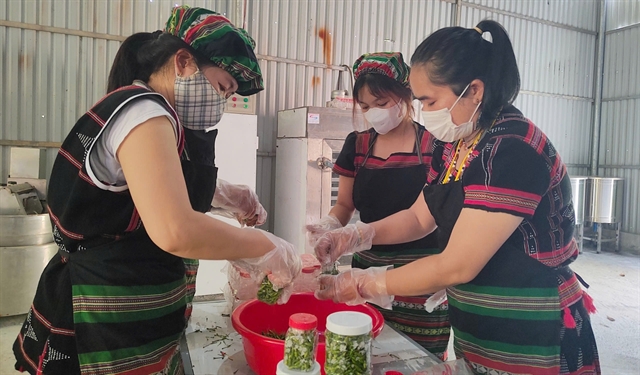 Society
Society

 |
| Cơ Tu ethnic farmers collect hot chillies on their farms in Đông Giang District of the central province of Quảng Nam. Photo courtesy of Kinh Quốc |
By Kinh Quốc
A rare species of tiny, fiery chilli, locally named A Riêu, native of the mountainous district of Đông Giang in the central province of Quảng Nam has become a sought-after spice that is transforming local livelihoods.
The wild chilli was named after the red-whiskered bulbul bird (Pycnonotus jocosus) in the Cơ Tu ethnic group’s language. It is derived from a local legend that these birds would eat the fruit and disperse its seeds throughout the forest. This very hot pepper is now a key source of income, through sales and tours, for the people living in Đông Giang.
The A Riêu chilli thrives in the mountainous district, with its cool climate conditions and the spice is a favourite in the central province and nationwide with its hot and aromatic taste. It is an indispensable ingredient in the kitchen of the Cơ Tu.
 |
| Hot chillies are harvested from farms in the mountainous district of Đông Giang in Quảng Nam Province. The fruit is now a main crop of farmers in the district. Photo courtesy of Kinh Quốc |
A Rất Bói, chief of Mà Coi Commune, says that the tiny chilli was originally found growing wild in the forest, but it is now grown on farms as a commercial product for the community.
A report from the commune says that 247 out of 640 households – nearly 40 per cent of residents – in the commune are growing the chilli as a main crop along with maize and cassava.
Profitable fruit
A Riêu chilli is priced from VNĐ250,000 to VNĐ300,000 per kilo – marginally more expensive compared to other types – but for foodies it is worth it in terms of the unique flavour and because it is organic.
A Rất Thị Ý, a local farmer, says she grows 3,000 chilli plants on her farms, but at first she only thought it is only used for local gastronomy, not as a money-making crop.
But now the A Riêu chilli brand has earned a four-star Vietnamese OCOP certification as one of the top farm products of the district.
 |
| Workers are seen pickling A Riêu chilli for longer use. The tiny fruit is a favourite spicy ingredient in cooking among ethnic communities in Quảng Nam Province. Photo courtesy of Kinh Quốc |
In mapping out plans for sustainable growth, Đông Giang District has restructured their crop plan over 12 hectares with the participation of a hundred households in 2021-25. A well-planned chili farm allows year-round harvest with yields of 10.5 tonnes a hectare per year.
The local community also processes fresh chilli into various products including chilli sauce and salted chilli which can be used and stored for longer than the fresh spice.
In promoting the brand, the local community organised the first ever A Riêu Chilli Fair/Festival in Đông Giang, which was a rendezvous for eco-tours and visitors.
Different cultural activities and lifestyle exhibitions were introduced at the festival to promote the traditional Cơ Tu culture including drum playing, crossbow shooting and local cooking styles.
Vũ Lê, a tourist from Hà Nội, said she was impressed with the A Riêu chilli as a spicy ingredient of Mỳ Quảng (Quảng Nam-based flat rice noodle) – an intangible heritage recognised culture – at the festival.
Vơ Ních Ưn, a Cơ Tu man from Ba Commune in Đông Giang, said at the festival that he cooked his meals with the chilli every day.
A cooperation agreement on promoting and distribution of the chilli was inked by the Cổng Trời (Heaven Gate) Đông Giang Ecotourism site and the Mà Coi Agricultural Cooperative at the festival.
Lê Văn Dũng, chairman of the Quảng Nam People's Committee (provincial government) says that the festival was not only a chance to introduce a key farm produce, but helped promote agricultural cooperation and eco-tour service development among businesses and local farmers.
 |
Đinh Văn Bảo, vice chairman of the People's Committee of Đông Giang, says: "The A Riêu chilli variety is expected to help in improving the livelihoods and sustainable development of organic farming, biodiversity conservation and local community-based eco-tourism." VNS

.jpg)


